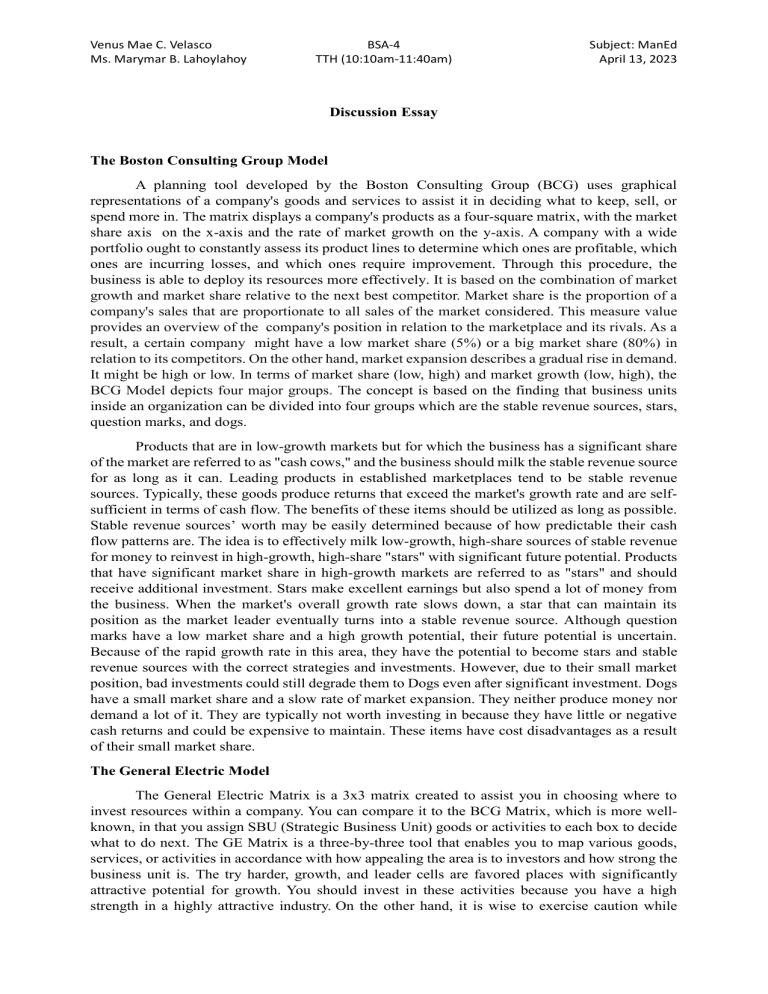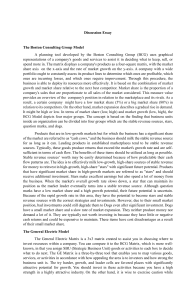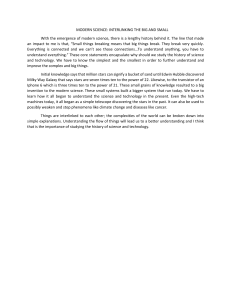
Venus Mae C. Velasco Ms. Marymar B. Lahoylahoy BSA-4 TTH (10:10am-11:40am) Subject: ManEd April 13, 2023 Discussion Essay The Boston Consulting Group Model A planning tool developed by the Boston Consulting Group (BCG) uses graphical representations of a company's goods and services to assist it in deciding what to keep, sell, or spend more in. The matrix displays a company's products as a four-square matrix, with the market share axis on the x-axis and the rate of market growth on the y-axis. A company with a wide portfolio ought to constantly assess its product lines to determine which ones are profitable, which ones are incurring losses, and which ones require improvement. Through this procedure, the business is able to deploy its resources more effectively. It is based on the combination of market growth and market share relative to the next best competitor. Market share is the proportion of a company's sales that are proportionate to all sales of the market considered. This measure value provides an overview of the company's position in relation to the marketplace and its rivals. As a result, a certain company might have a low market share (5%) or a big market share (80%) in relation to its competitors. On the other hand, market expansion describes a gradual rise in demand. It might be high or low. In terms of market share (low, high) and market growth (low, high), the BCG Model depicts four major groups. The concept is based on the finding that business units inside an organization can be divided into four groups which are the stable revenue sources, stars, question marks, and dogs. Products that are in low-growth markets but for which the business has a significant share of the market are referred to as "cash cows," and the business should milk the stable revenue source for as long as it can. Leading products in established marketplaces tend to be stable revenue sources. Typically, these goods produce returns that exceed the market's growth rate and are selfsufficient in terms of cash flow. The benefits of these items should be utilized as long as possible. Stable revenue sources’ worth may be easily determined because of how predictable their cash flow patterns are. The idea is to effectively milk low-growth, high-share sources of stable revenue for money to reinvest in high-growth, high-share "stars" with significant future potential. Products that have significant market share in high-growth markets are referred to as "stars" and should receive additional investment. Stars make excellent earnings but also spend a lot of money from the business. When the market's overall growth rate slows down, a star that can maintain its position as the market leader eventually turns into a stable revenue source. Although question marks have a low market share and a high growth potential, their future potential is uncertain. Because of the rapid growth rate in this area, they have the potential to become stars and stable revenue sources with the correct strategies and investments. However, due to their small market position, bad investments could still degrade them to Dogs even after significant investment. Dogs have a small market share and a slow rate of market expansion. They neither produce money nor demand a lot of it. They are typically not worth investing in because they have little or negative cash returns and could be expensive to maintain. These items have cost disadvantages as a result of their small market share. The General Electric Model The General Electric Matrix is a 3x3 matrix created to assist you in choosing where to invest resources within a company. You can compare it to the BCG Matrix, which is more wellknown, in that you assign SBU (Strategic Business Unit) goods or activities to each box to decide what to do next. The GE Matrix is a three-by-three tool that enables you to map various goods, services, or activities in accordance with how appealing the area is to investors and how strong the business unit is. The try harder, growth, and leader cells are favored places with significantly attractive potential for growth. You should invest in these activities because you have a high strength in a highly attractive industry. On the other hand, it is wise to exercise caution while Venus Mae C. Velasco Ms. Marymar B. Lahoylahoy BSA-4 TTH (10:10am-11:40am) Subject: ManEd April 13, 2023 making additional investments in the improve or quit, proceed with care, and cash generation cells due to their moderate attraction. Although not always at the point of exit, activities that fall under this group are less appealing for investment than the first three activities. The final three cells— the phase withdrawal and withdrawal—are not appealing, and the corporation has to consider leaving. If business is weak and the market is unattractive, you should think about shutting company or leaving. It is crucial to remember that these are just guidelines and not rules, so bear in mind that you also need to consider the bigger picture and the potential of your business unit, market, and industry structure. Global Strategies The phrase "global strategy" refers to three distinct categories: global, multinational, and international strategies. All three of these strategies help an organization accomplish its goal of global expansion. It is helpful to distinguish between three types of worldwide expansion that result from a company's resources, capabilities, and current international position while formulating "global strategy." The company's strategies outside of its home markets can be viewed as international if it is still primarily focused on those markets. For an instance, A dairy business might sell part of its extra milk and cheese supplies outside of its home country. But the domestic market continues to be its primary strategic focus. The other one is when a corporation may have entered a variety of areas as its international activities have grown, and each market requires a unique strategy. These plans come together to make a multinational strategy. Importantly, each country's competitive advantage is assessed independently. Moreover, some businesses' worldwide operations have advanced to the point where they treat the entire world as one market with just slight modifications for each country or global area. We refer to this as a global strategy. It is important to note that competitive advantage is mostly created on a global basis. Following global strategies may be beneficial for firms due to the larger market for its products. Businesses may see an increase in sales and earnings. They can profit from the wide availability of their goods and services in addition to the economies of scale. The twenty-first century is a time of limitless reality. The ability to communicate, use technology, move throughout the world, and, in particular, do business or provide services, are all global phenomena. Global strategies are now considered as a result. Global markets, international expansion, and global products present a needed alternative for some organizations.





